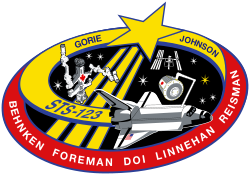Gregory Johnson
| Gregory Johnson | |
|---|---|
 | |
| NASA Astronaut | |
| Statsborger | USA |
| Nationalitet | Amerikansk |
| Status | Aktiv |
| Født | 12. maj 1962 Alder 60 Middlesex, Storbritannien |
Andet arbejde | Testpilot |
| Uddannelses- sted | United States Air Force Academy U.S. Air Force Test Pilot School Columbia School of Engineering and Applied Science Fairborn High School |
| Rang | Oberst, USAF |
| Udvælgelse | NASA-gruppen fra 1998 |
| Mission(er) | STS-123 STS-134 næste mission. |
| Missionsemblemer | |
Gregory Harold Johnson også kaldet Gregory Harold "Box" Johnson (født 12. maj 1962) er en NASA-astronaut og han har fløjet en rumfærgemission; STS-123 som 2.-pilot.
Johnson fløj 34 kampmissioner med F-15E Strike Eagle under Golfkrigen og 27 kampmissioner over Sydirak i 1992-93. Bagefter var han testpilot på Edwards Air Force Basen hvor han fløj over 3.500 timer på mere end 40 flytyper.
Gregory Johnson skal være 2.-pilot på STS-134 i februar 2011.
Eksterne henvisninger
- NASA Biografi af Gregory Johnson (engelsk)
- interview Arkiveret 13. marts 2008 hos Wayback Machine (engelsk)

Spire Denne biografi om en amerikaner er en spire som bør udbygges. Du er velkommen til at hjælpe Wikipedia ved at udvide den.
Medier brugt på denne side
STS-123 continues assembly of the International Space Station (ISS). The primary mission objectives include rotating an expedition crew member and installing both the first component of the Japanese Experimental Module (the Experimental Logistics Module - Pressurized Section (ELM-PS)) and the Canadian Special Purpose Dexterous Manipulator (SPDM). In addition, STS-123 will deliver various spare ISS components and leave behind the sensor boom used for inspecting the shuttle's thermal protection system. A follow-on mission to ISS will utilize and then return home with this sensor boom. A total of five spacewalks are planned to accomplish these tasks. The mission will also require the use of both the shuttle and ISS robotic arms. STS-123 will utilize the Station-Shuttle Power Transfer System to extend the docked portion of the mission to eleven days, with a total planned duration of 15 days. The crew patch depicts the space shuttle in orbit with the crew names trailing behind. STS-123's major additions to ISS (the ELM-PS installation with the shuttle robotic arm and the fully constructed SPDM) are both illustrated. The ISS is shown in the configuration that the STS-123 crew will encounter when they arrive.
The design of the STS-134 crew patch highlights research on the International Space Station (ISS) focusing on the fundamental physics of the universe. On this mission, the crew of Space Shuttle Endeavour will install the Alpha Magnetic Spectrometer (AMS) experiment - a cosmic particle detector




